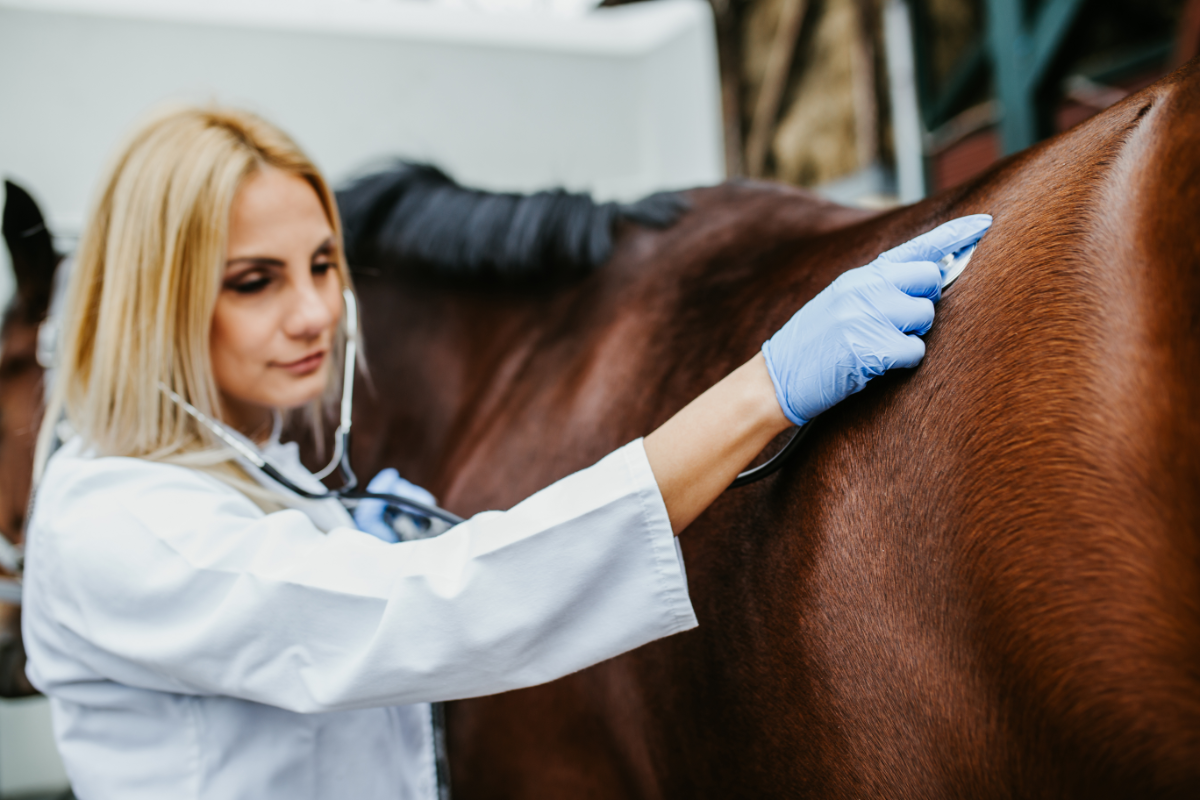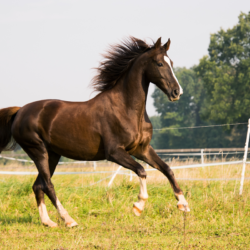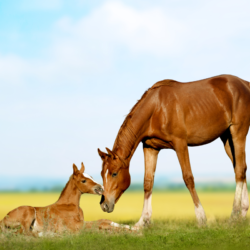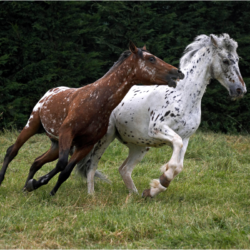Bacterial folliculitis is a common skin condition in horses that is often misdiagnosed or underestimated. This infection, although superficial, can lead to serious complications if it is not treated quickly. Whether you are an owner or an animal health professional, understanding this condition is essential to ensure the well-being of your horses.
What causes this disease?
Bacterial folliculitis results from infection of the hair follicles by bacteria such as Staphylococcus aureus or Staphylococcus pseudintermedius. Present in low densities on healthy skin, these bacteria proliferate as soon as the skin barrier is compromised.
Common causes of this alteration include :
- Physical trauma: ill-fitting tack, repeated rubbing, abrasions.
- Environmental conditions: excessive humidity and poor hygiene in stables.
- Immune dysfunction: immunodeficiencies or metabolic diseases (e.g. diabetes).
- Skin allergies: weakening the natural protective barrier.
S. aureus, in particular, is a formidable opportunistic pathogen. It can be isolated both from the healthy skin of horses and from infected lesions. Its mere presence is not always synonymous with active infection, which complicates diagnosis. However, when it invades tissues, it triggers characteristic inflammatory and purulent reactions.
Primary infections develop without any identifiable cause, while secondary infections are often linked to underlying lesions or diseases. In advanced cases, poor management can lead to chronic conditions or serious complications.
What are the symptoms of bacterial folliculitis?
The symptoms of bacterial folliculitis vary depending on the severity and location of the lesions, but there are typical signs associated with infection of the hair follicles.
Superficial manifestations
- Papules and pustules: small purulent lesions centred around a hair follicle.
- Crusts and areas of depilation: the coat may have a mottled appearance, and circular alopecic patches may appear.
- Skin sensitivity: infected areas are often red and slightly swollen.
Advanced cases
When the disease progresses without treatment, complications may arise, including :
- Furunculosis: formation of painful, necrotic boils. These lesions may release pus and leave red craters after removal.
- Cellulitis: deep inflammation leading to suppuration and the formation of fistulas.
- Botryomycosis: a rare chronic condition characterised by granulation tissue and persistent lesions requiring prolonged treatment.
Lesions are often located in areas of friction, such as the back, shoulders or rump. Although itching is rare, deep infections quickly become painful and can affect the animal’s comfort.
How is the condition diagnosed?
Diagnosis of bacterial folliculitis is based on clinical assessment and specific tests.
Clinical examination
The veterinarian examines the skin lesions to identify characteristic papules, pustules or crusts. The affected areas are palpated to assess their sensitivity and determine the extent of the infection.
Laboratory tests
- Skin cytology: This rapid and essential test involves analysing skin samples under a microscope. It detects the presence of bacteria (particularly S. aureus) and inflammatory cells.
- Bacterial culture and antibiotic susceptibility test: These in-depth analyses identify the precise bacteria involved and their sensitivity to antibiotics. They are crucial in cases of suspected bacterial resistance, particularly to methicillin-resistant S. aureus (MRSA).
The differential diagnosis includes other skin pathologies such as dermatophytosis or ectoparasitosis. If in doubt, additional tests may be carried out.
What treatments are available?
The treatment of bacterial folliculitis combines topical care and systemic antibiotics, adapted to the severity of the lesions and the possible presence of bacterial resistance.
Topical treatments
- Antiseptic shampoos: based on chlorhexidine or benzoyl peroxide, to disinfect and limit the spread of infection.
- Antibiotic ointments and creams: prescribed for localised, superficial lesions.
- Antimicrobial and antifungal sprays: useful as a complement to treat sensitive areas and prevent mycotic superinfection.
Systemic antibiotic therapy
When lesions are deep or extensive, oral antibiotic therapy is necessary. Its duration varies from 3 to 8 weeks depending on the clinical response. Persistent symptoms may require adjustment based on an antibiogram.
Regular veterinary monitoring is essential to validate the efficacy of the treatment and prevent recurrences.
What is the impact of antibiotic resistance?
Antibiotic resistance is a growing issue in veterinary medicine, particularly with bacteria such as methicillin-resistant Staphylococcus aureus (MRSA). This resistance poses a major challenge in the treatment of skin infections, particularly in horses suffering from bacterial folliculitis.
Bacterial resistance develops when a bacterium, such as S. aureus, acquires mutations or specific genes that neutralise the effectiveness of antibiotics. In the case of MRSA, the mecA gene modifies an essential binding protein (PBP), preventing beta-lactam antibiotics such as methicillin from working properly. What’s more, these resistant strains often have multiple resistance to other classes of antibiotics, limiting the choice of treatment.
Antibiotic resistance prolongs infections, increases treatment costs and, in some cases, leads to therapeutic failure. In horses, it particularly complicates the management of recurrent folliculitis and can encourage nosocomial transmission of resistant strains in stables or during hospitalisation. This situation is all the more worrying in that certain strains of MRSA detected in horses are similar to those found in humans, highlighting a potential risk of inter-species transmission.
To limit antibiotic resistance, it is essential to :
- Carry out an antibiotic susceptibility test before any treatment, to identify precisely which antibiotics are effective.
- Reserve the use of critical antibiotics for cases where no other option is viable.
- Favour topical treatments whenever possible, to reduce the pressure exerted on the bacteria.
- Strengthen surveillance in hospitals to prevent nosocomial transmission.
By combining these measures, it is possible to limit the spread of resistant strains while maintaining the effectiveness of available treatments.
What are the natural alternatives?
Natural treatments can be used alongside conventional therapies to strengthen the skin barrier and soothe lesions.
- Essential oils: Certain oils, such as tea tree or lavender, have antibacterial properties and can be applied diluted to the affected areas.
- Aloe vera: Known for its soothing and healing properties, it is particularly useful for soothing irritations.
- Food supplements: Adding omega-3 and omega-6 fatty acids to the diet can improve overall skin health.
- Green clay: Used as a poultice, it helps to purify and disinfect lesions.
- Blackcurrant bud: thanks to its cortison-like action, blackcurrant bud macerate helps to relieve the animal’s pain.
Consult a vet before using these solutions to ensure they are appropriate for your pet’s condition.
What are the means of prevention?
Preventing bacterial folliculitis involves rigorous hygiene measures and paying particular attention to the horse’s general condition.
- Hygiene: Regularly clean the coat, tack and equipment to eliminate pathogens.
- Living conditions: Keep stables clean and well-ventilated to avoid dampness, a factor that encourages infection.
- Parasite control: Use anti-parasitics to minimise the risk of bites and skin lesions.
- Monitoring: Inspect your horse’s skin frequently for the first signs of infection.
A balanced diet and regular care also help to boost your horse’s natural defences, reducing the risk of recurrence.





